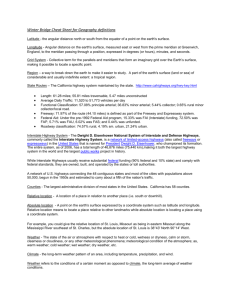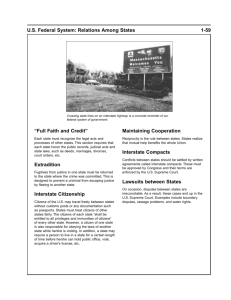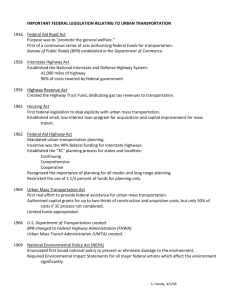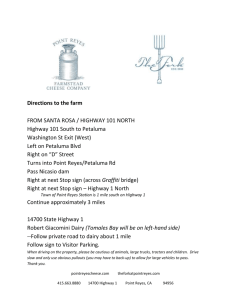The Engineering of the Interstate Highway System
advertisement
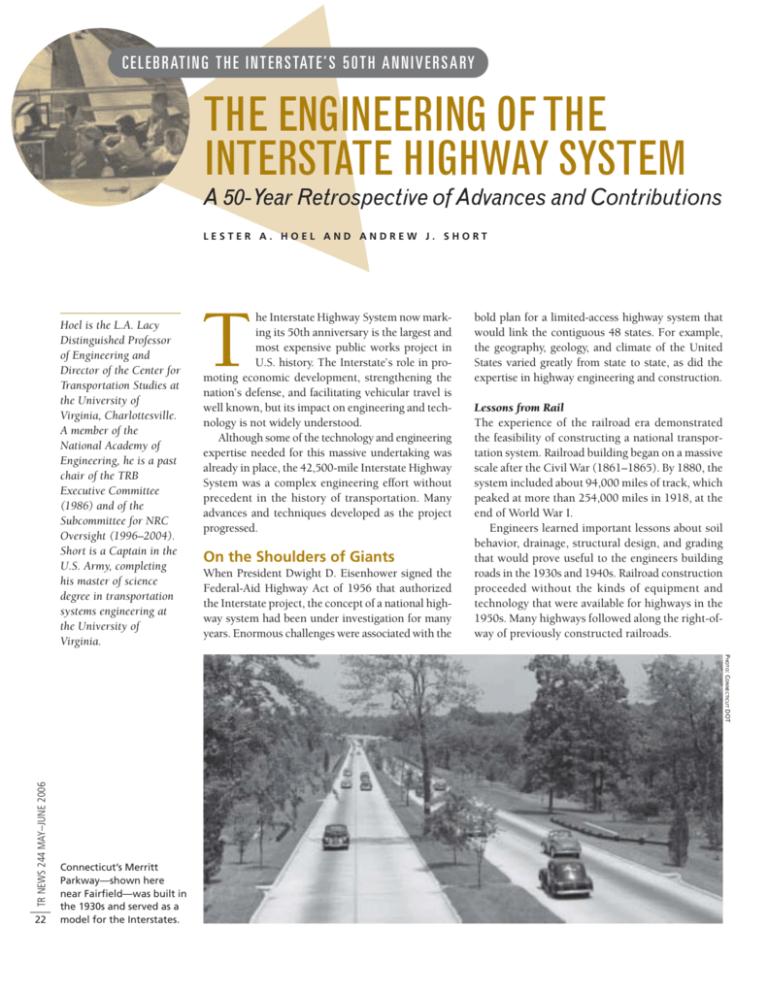
C E L E B R AT I N G T H E I N T E R S TAT E ’ S 5 0 T H A N N I V E R S A RY THE ENGINEERING OF THE INTERSTATE HIGHWAY SYSTEM A 50-Year Retrospective of Advances and Contributions LESTER A. HOEL AND ANDREW J. SHORT Hoel is the L.A. Lacy Distinguished Professor of Engineering and Director of the Center for Transportation Studies at the University of Virginia, Charlottesville. A member of the National Academy of Engineering, he is a past chair of the TRB Executive Committee (1986) and of the Subcommittee for NRC Oversight (1996–2004). Short is a Captain in the U.S. Army, completing his master of science degree in transportation systems engineering at the University of Virginia. T he Interstate Highway System now marking its 50th anniversary is the largest and most expensive public works project in U.S. history. The Interstate’s role in promoting economic development, strengthening the nation’s defense, and facilitating vehicular travel is well known, but its impact on engineering and technology is not widely understood. Although some of the technology and engineering expertise needed for this massive undertaking was already in place, the 42,500-mile Interstate Highway System was a complex engineering effort without precedent in the history of transportation. Many advances and techniques developed as the project progressed. On the Shoulders of Giants When President Dwight D. Eisenhower signed the Federal-Aid Highway Act of 1956 that authorized the Interstate project, the concept of a national highway system had been under investigation for many years. Enormous challenges were associated with the bold plan for a limited-access highway system that would link the contiguous 48 states. For example, the geography, geology, and climate of the United States varied greatly from state to state, as did the expertise in highway engineering and construction. Lessons from Rail The experience of the railroad era demonstrated the feasibility of constructing a national transportation system. Railroad building began on a massive scale after the Civil War (1861–1865). By 1880, the system included about 94,000 miles of track, which peaked at more than 254,000 miles in 1918, at the end of World War I. Engineers learned important lessons about soil behavior, drainage, structural design, and grading that would prove useful to the engineers building roads in the 1930s and 1940s. Railroad construction proceeded without the kinds of equipment and technology that were available for highways in the 1950s. Many highways followed along the right-ofway of previously constructed railroads. TR NEWS 244 MAY–JUNE 2006 PHOTO: CONNECTICUT DOT 22 Connecticut’s Merritt Parkway—shown here near Fairfield—was built in the 1930s and served as a model for the Interstates. Highway Precedents Limited-access highways in America were not unknown in 1956. Parkways and freeways had been constructed in several states between 1920 and 1945. The Henry Hudson and Bronx River Parkways in New York, the Merritt Parkway in Connecticut, and the Arroyo Seco Parkway in Los Angeles are early examples of highways that served as models for the Interstates. Perhaps the best example of an early limitedaccess highway is the Pennsylvania Turnpike. Modeled after the German autobahns, the Pennsylvania Turnpike opened in 1940 with higher geometric and design standards than had been applied in the United States. The facility still serves as a major east–west artery in Pennsylvania and is now a segment of the Interstate system. Interstate design standards would be based on similar principles. World War II Experience World War II had an impact on the development of the highway engineering expertise that would be needed to design and build the Interstate. Military engineers faced large and complex challenges in the European and Pacific theaters. Many construc- tion projects—including roads, bridges, airstrips, and harbor facilities—were completed quickly and under adverse conditions. When hostilities ended in 1945, many returning servicemen enrolled in engineering schools funded by a federal grant known as the GI Bill. Some attended state or private universities that were redirecting their training and research programs toward this new area of studies. Schools such as the University of California at Berkeley, Yale University, and Northwestern University were early leaders in highway engineering and traffic management education. State highway departments, as well as the U.S. Bureau of Public Roads1 (BPR) and consulting firms, eagerly employed engineering graduates to embark on careers that would center on the Interstate system. World War II also advanced the state of U.S. construction practice. Servicemen returning from the war had experience with construction equipment. In addition, the expanding manufacturing sector brought the development of highway construction equipment to a new level of performance. Overcoming Constraints Several unique engineering problems faced the engineers who were tasked with building the Interstate system. The problems centered around three constraints: the size of the project, the scope of the project, and the time required to complete the project. The enabling legislation had anticipated completion within 13 years, but engineers soon learned that the scope and cost of the project would greatly exceed early estimates of the materials and personnel required. In contrast to earlier projects, in which the major challenge was conquering nature, the 1 Now the Federal Highway Administration. The Lincoln Tunnel under the Hudson River between New York City and New Jersey was an engineering achievement that provided know-how for the building of the Interstate system. TR NEWS 244 MAY–JUNE 2006 Bridge and Tunnel Models Many railroad and highway bridges and tunnels were constructed in the 19th and early 20th centuries, well before Interstate highways. The Holland Tunnel, which opened in 1927, connected lower Manhattan with New Jersey. It was the world’s first long, underwater, mechanically ventilated tunnel. The twin-tube design consisted of 115,000 tons of cast iron and 130,000 cubic yards of concrete. The Lincoln Tunnel, the second tunnel under the Hudson River, opened in 1937 and remains a significant crossing for the New York metropolitan area. Both tunnels served as models for those to be constructed during the Interstate era for highway and rail transit. The George Washington Bridge, completed in 1931, connected New York City with northern New Jersey. Built over a four-year period, its two steel towers with a span length of 3,500 feet are embedded deep in rock and concrete. The towers rise more than 600 feet to support steel suspension cables that contain more than 107,000 miles of wire. The bridge carries approximately 300,000 vehicles per day and is one of the most heavily traveled bridges in the world. In 1937, the Golden Gate Bridge connected San Francisco to Northern California. Its 4,200-foot span is an engineering achievement that continues to serve as a major artery for the California highway system. The Golden Gate Bridge between San Francisco and Northern California took 4 years to build; Golden Gate Strait below is 400 feet deep, and the bridge’s two towers rise 746 feet. 23 PHOTO: AASHTO Construction on the Pennsylvania Turnpike in the late 1930s. The Interstate precursor raised U.S. geometric and design standards for highways. TR NEWS 244 MAY–JUNE 2006 Researchers film and record data after a test truck crosses a bridge during the AASHO Road Test, which contributed to the development of design criteria and standards for the Interstates. 24 Interstate system was conceived as a means to connect cities and to relieve traffic congestion. Consequently, engineers were constructing these facilities in a difficult and more hostile environment. The Interstate Highway System became known as the most extensive engineering project since the construction of the Great Pyramids. The complexity and challenges of the project greatly exceeded those faced by earlier builders of the nation’s transportation infrastructure. Contractors expended about 2.6 billion person-hours building Interstate highways and used more than 1.5 million tons of explosives to excavate material in large cut sections and tunnels. State Preparations Although the federal government provided at least 90 percent of the cost, individual highway departments were responsible for building the segments of the system within their state. The Federal Aid Road Act of 1916 required all states to establish a department of highways as a condition for receiving federal funds. Only a few states, however, had the expertise and the engineering staffs qualified to design and construct highways at an Interstate scale. Many agencies competed to secure qualified engineers; those who were hired became “the Interstate generation.” States such as New York, California, and Pennsylvania had organizations with seasoned employees who were prepared for the challenges. Inhouse staff, contractors, and consultants would establish working relationships during the course of the Interstate program. States shared enthusiasm and excitement for the work. Ellis Armstrong, BPR Commissioner from 1958 to 1961, predicted “many obstacles” and conceded, “We’re up against a pretty tough schedule.” Nonetheless he believed that the industry would respond and the Interstates could be built on schedule. State highway engineers recognized the Interstate as a challenge and an opportunity of a lifetime. Although the desire to succeed was strong, concerns arose that shortages of engineers, materials, construction equipment, and contractors could hinder completion. Uniformity in Practice Fortuitously, by 1956, through the efforts of BPR, the American Association of State Highway Officials2 (AASHO), and the Highway Research Board3 (HRB), a network was in place for creating and transmitting technical information between state highway departments. The process for communication and the establishment of design policies had been perfected during the first half of the 20th century, long before the Interstate system was begun, during a period when highway building was an active priority in many states. BPR, established in 1893 as the Office of Road Inquiry, helped state and local governments to create road projects that would employ workers during the Great Depression of the 1930s and spearheaded the federal government’s involvement in national highway building, including the Interstate system. AASHO, formed in 1914, facilitated coordination between states, brought an orderly arrangement to road systems, established standards for construction, and promoted highway development. HRB, organized in 1920 as part of the National Research Council associated with the National Academy of Sciences, established relationships between the states and the federal government to serve as a facilitator of highway research and to assist in dissemination of new information to the highway community. These three organizations were instrumental in developing uniformity and consistency in engineerNow the American Association of State Highway and Transportation Officials. 3 Now the Transportation Research Board. 2 SOURCE: IOWA DOT ing practice throughout the country, a necessity for the successful completion of a system with the Interstate’s scale. Engineers could tailor design criteria to special conditions, and lines of communication emerged as the nation was inventing the modern discipline of highway engineering. Design and Construction Standards An important feature of the Interstate is the uniformity in design practice to assure safety and efficient operations. Design standards could be modified, however, as innovations and new techniques were developed. In partnership, AASHO and BPR assembled and codified the knowledge gained by states before the Interstate project and communicated the information to all state highway departments. The partnership proved valuable in sharing technical knowledge and in establishing consensus within the engineering community. Research Studies The policies published by AASHO were the result of proven engineering research and experience, based on studies conducted by BPR, the National Cooperative Highway Research Program (NCHRP) established under HRB in 1962, state research laboratories, and universities. The partnership effectively disseminated information in such subject areas as geometric design, pavement and bridge design, highway capacity, and traffic control. Highway departments could build Interstate projects because of these established standards, which were based on results secured from state practice. Many states had minimal experience in building limited-access highways. Yet through creativity, sensitivity, and engineering practice, each state could construct highways that were uniform in some respects, but also unique to the settings. Prototype slip-form paver, developed in the Iowa DOT laboratory in Ames, produced sidewalk-size sections of concrete in 1948, and soon yielded a model that produced sections 9 feet wide and 6 inches deep. Advances in Technology The construction of the Interstates produced significant advances in civil engineering technology, particularly in asphalt and concrete pavements, drainage, bridge design, soil mechanics, and traffic forecasting. In 1876, Belgian chemist Edmund DeSmedt supervised the asphalt paving of Pennsylvania Avenue in Washington, D.C., and in 1891, George Bartholomew paved Main Street in Bellefontaine, Ohio, with concrete. Soon other cities in the East and Midwest began paving their roads. Paved roads, however, rarely ventured outside of cities. When automobiles arrived, the need for hardsurface roads was critical, prompting efforts to discover how to build better pavements. Engineers had limited knowledge of the properties of concrete and asphalt before the Interstate, especially about the wearing and load-bearing characteristics. Between 1945 and 1955, the total number of automobiles in the nation doubled to 61 million. States had conducted quality testing of pavements, but the requisite knowledge was not developed until the AASHO Road Test. The Interstates were to be designed for 20 years of service, but many sections lasted many more years, and some portions have carried three to four times the loads for which they were designed. TR NEWS 244 MAY–JUNE 2006 AASHO Road Test One of the most significant research projects of the Interstate era was the AASHO Road Test, conducted between 1958 and 1960. The purpose of the project was to develop pavement design criteria for Interstate conditions. Standards for asphalt and concrete pavements and for bridge design would assure a long design life that could withstand expected increases in heavy truck travel. The testing was conducted in Ottawa, Illinois, and consisted of more than 800 concrete and asphalt pavement sections arranged in six loops. Each lane on the loop carried traffic with axle loads ranging from 2,000 to 30,000 pounds. Test vehicles, driven by members of the U.S. Army, traveled around the loops continuously for more than two years. The pavement conditions were measured and analyzed to produce pavement design relationships describing how various pavement structures would deteriorate with exposure to traffic. The results became the basis for pavement design practice in the United States and throughout the world. The AASHO Road Test advanced knowledge of pavement structural design, pavement performance, load equivalencies, climatic effects, and the design of short-span bridges. 25 TR NEWS 244 MAY–JUNE 2006 Telegraph Pass, Interstate 8, near Yuma, Arizona. 26 Asphalt Asphalt technology greatly improved during World War II because military aircraft required surfaces that could withstand heavy loads. But Interstate construction called for larger equipment than was available. Electronic leveling controls, extrawide finishers for paving two lanes at once, and vibratory steelwheel rollers were developed. Innovative construction techniques that now are considered state of the art included rubblization and crack-and-seat methods, which enabled the use of worn roadbeds as the foundation for asphalt surfacing. The basic principles of highway construction remain the same, but many elements have changed in the past 50 years. Recent improvements in asphalt pavement design include Superpave®, stone-matrix asphalt, and open-graded friction courses. Superpave—which stands for Superior Performing Asphalt Pavement—can be tailored to climate and traffic and has shown durability in highway performance. The open-graded friction course design has improved surface drainage of water, reducing hydroplaning and skidding. Research to produce a quieter, more durable, and economical paving material continues. Under way is the development of warm-mix asphalt, which may lower the production and construction temperature for asphalt pavement material by 50 to 100 degrees. This new technology would require less energy to produce the mix; would reduce emissions, fumes, and odor; and would age more slowly in production, making it less prone to cracking. Concrete Concrete generally has a higher initial cost than asphalt but lasts longer and has lower maintenance costs. The first concrete roads were primitive, and each was unique to the builder. From the 1920s until 1960, the concrete for pavements was produced on-site. With the development of a large central mixer, concrete trucks could take the mix directly to the project site, improving the speed of the concrete placement and the quality of the mix. The central plant mixer was up to 12 times faster than on-site production. Another advance in concrete paving was the slipform paver, developed in an Iowa laboratory in 1947. Two years later, a slip-form paver was available that produced a section 9 feet wide and 6 inches deep. With the construction of the Interstate, larger and more efficient pavers were developed, greatly increasing construction workers’ productivity. Other improvements in concrete technology include fiber reinforcement and superplasticizers for admixtures. High-performance concrete was intro- duced in 1987. Areas of ongoing research on concrete pavements include improving information for inputs into pavement management systems, comparing the performance of alternative designs under dynamic loads, finding solutions to durability problems, and developing more economical ways of recycling and reconstructing old pavements. The goal is to devise mixtures that are economical and long-lasting. Although high-quality concrete was available in small quantities at the inception of the Interstate, quality control often was sacrificed for speedy construction. Engineers and contractors later fully understood the implications of high-quality concrete for durability and longevity. Culverts and Drainage The Interstate also advanced drainage techniques, including culvert design and materials. Before the Interstate, culverts were made of clay or concrete, and during the 1950s, highway builders used metal or concrete culverts. Today the development of plastic pipes has provided engineers with another alternative. In a recent project in Salt Lake City, Utah, for example, corrugated polyethylene pipe allowed completion of a $1.5 billion project on I-15 in time for the 2002 Winter Olympics. The pipe’s long length reduced the number of joints, saving labor and installation time. Bridges As noted earlier, many long- and short-span bridges for railroads and highways had been constructed before the Interstate. For example, the Brooklyn Bridge opened in 1883. Yet the dramatic progress in bridge engineering during the Interstate years is illustrated by a partial list of advances that came into widespread use on highway bridges during the past 50 years: prestressed concrete, segmental construction, high-performance concrete, high-strength steel, weathering steel, welded connections, computerized analysis and design, cable-stayed spans, elastomeric bearings, epoxy-coated reinforcement, radiographic inspection, and bridge management systems. Planning Travel forecasting was necessary for Interstate planning because the design had to size the system to accommodate traffic volumes 20 years into the future. In contrast to other aspects of engineering design, the state of the art in travel forecasting was in its infancy. Large-scale urban transportation planning studies had been initiated in cities such as Chicago, Detroit, and Los Angeles. The pioneer effort was the 1955 Operations and Safety Travel monitoring was another challenge for highway engineers. Among the many advances in this area is the first high-tech roadway, the 27-kilometer Glenn Anderson Freeway–Transitway, I-105 in Los Angeles. This Interstate section, which opened in 1993, features the latest in highway technology, with sensors buried in the pavement and links to computers that allow technicians to monitor traffic flow. In addition to meters that help regulate traffic on ramps, closed-circuit television cameras alert officials to accidents on the highway. Road safety standards also have improved in the past 50 years. As early as 1960, researchers were developing reflective markings for highway pavements. Other developments include guardrail designs such as the Jersey Barrier, breakaway signs, clear zones, and reflectorized traffic signs. Construction zone practices assure safety for highway workers. Statistics show that the Interstates have had the best safety record of all classes of roadways. length and that feature two mile-long tunnels beneath the ocean bottom to allow passage of commercial and military ships. The most recent engineering challenge was the I90 and I-93 Central Artery–Tunnel Project, or Big Dig, in Boston, Massachusetts. The original elevated highway was chronically congested, plagued by sharp turns and many entrance and exit ramps. Engineers employed the slurry wall technique to create 120-foot deep concrete walls on which the old highway could rest while a new road was constructed below. The concrete walls also stabilized the construction site and prevented cave-ins during the tunneling. Completed over budget and five years behind schedule, the $15 billion project nonetheless is considered an outstanding engineering accomplishment. Boston’s 14-year Central Artery–Tunnel Project, known as the Big Dig, has reconfigured the juncture of I-90 and I-93. Looking Ahead Engineers will continue to address challenges in maintaining, improving, and adapting the Interstate Highway System to the needs of the future and to the information age. The can-do attitude of the Interstate generation remains the standard for transportation engineers today and in the future. As Stephen D. Bechtel, Jr., a noted engineer and highway builder, has stated: “For those of us who are fortunate to have been trained and to serve as engineers, there is great satisfaction in working on historic and important infrastructure projects. They improve the quality of life, in both safety and convenience, and facilitate improved commerce and economic growth around the world.” As the 21st century begins, the engineers and planners who designed and built the Interstate Highway System are in the twilight of their careers. It is important to remember the lessons learned and skills acquired in completing the Interstate Highway System. The torch has passed to a new generation of transportation engineers who will face new challenges in a fast and changing technological world. TR NEWS 244 MAY–JUNE 2006 Other Advances The Interstate has brought with it many advances that have contributed not only to the highway, but to many other engineering projects. Engineers have adapted highway design to comply with environmental laws and regulations. For example, in Florida’s Everglades, the construction of I-75—known as Alligator Alley— included underpasses that allow the endangered Florida panther and other wildlife to cross under the highway. Improved drainage also has enhanced the flow of water within the Everglades. The Chesapeake Bay Bridge–Tunnel in Norfolk, Virginia, opened in 1964 and was named one of the “Seven Engineering Wonders of the Modern World” in a 1965 competition. The structure connects Virginia Beach and Norfolk to Virginia’s Eastern Shore, with bridges and tunnels that total 17.6 miles in SOURCE: MASSACHUSETTS TRANSIT AUTHORITY Chicago Area Transportation Study, which developed a series of models to forecast traffic patterns and flow based on a four-step methodological procedure that included trip generation, trip distribution, modal split, and traffic assignment. Many of these models are still in use today. Other contributors were Alan Voorhees, whose seminal paper, “A General Theory of Traffic Movement,” proposed a “gravity model” for forecasting trip origins and destinations. His planning firm and others completed many transportation studies applying these principles. BPR perfected the planning methods developed for the Interstate, which have been implemented in many urban transportation studies in the United States and worldwide. 29
